Multifunctional plant for contract packers
Big bag emptying, straining and protective sieving, conveying
Contract packers are fulfillment service providers who, in addition to pure packaging, also handle upstream and downstream processes such as warehousing, dosing, filling, packaging and picking, as well as on-time delivery of goods to retailers.
Since contract packers rarely work for just one industry, they must be able to manage a wide range of different products from different industries.
It is not uncommon for them to act as an extended workbench for the customer and take over individual process steps. For example, if this involves the dosing and packaging of a pharmaceutical product, the same production standards and hygiene regulations apply to the contract packer as to the actual manufacturer.
In this particular case, the customer was looking for a flexible big bag emptying system to set up an emptying line consisting of 3 big bag stations.
- What specifications had to be taken into account in the system planning?
- Which solutions were found to map the process steps “big bag emptying” and “discharge”?
- How flexible is this multifunctional plant with regard to the handling of different bulk materials, including abrasive materials?
- How were the aspects of safety and user-friendliness taken into account?
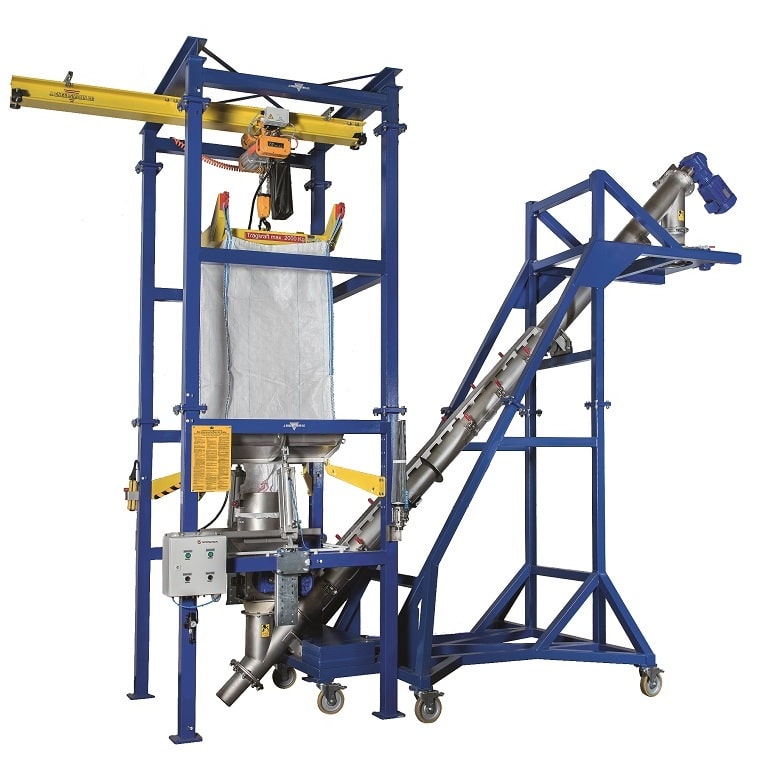
Individual plant development for maximum flexibility: Big Bag emptying station with integrated screening technology and downstream mechanical or pneumatic conveying of the product.
Project challenges:
Big bag emptying for products with a wide variety of properties and their efficient emptying.
And all this with minimum changeover times and limited space.
The emptying line is planned for a two-story production hall. The big bag emptying stations are located on the lower floor. Due to the low hall ceiling, a maximum overall height of 4.8 m was specified. The downstream weighing and bagging machines are located on two levels, requiring two differently designed inclined screws. Since there is also little space available in the width, a comparatively steep angle was used to bridge the two levels in order to implement smooth product conveying from the lower to the upper level.
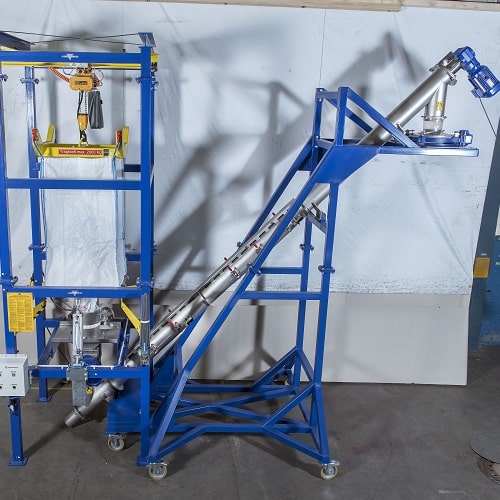
The big bag discharge station with inclined screw. A JEL Fix is mounted under its outlet at the top right as a compact protective screen.
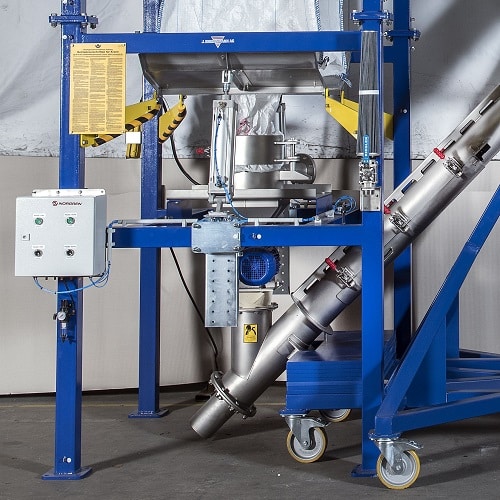
Emptying device, discharge hopper, pneumatic paddles and optionally with passing sieve in the compound. Subsequently, various conveying elements can be attached.
Extensive product specifications
The list of product specifications is extensive: powder, granule and pastille-shaped products, some of them abrasive. Variable bulk densities from 0.3 to 1.8 kg/l. Good and poorly flowing bulk materials, with a slight to strong tendency to agglomeration – the plant can handle it all. Different materials each place different demands on the emptying and conveying process. For this reason, a test environment was first set up in the Engelsmann pilot plant to simulate the process with the most critical products. This provided valuable knowledge for the plant planning and design of the three big bag stations. And the certainty that the plant would also function perfectly in actual operation.
Space-saving big bag emptying and additional pass sieving if the product tends to agglomerate.
Until now, the customer had been using technology for big bag emptying that was equipped with permanently installed, improvised conveying elements. This did not give the contract packer the opportunity to quickly adapt to the different products of his customers. However, rapid process adaptation in particular is essential in the packaging industry, as customer orders are often placed at short notice. The operator therefore wanted to replace this old system with a more flexible solution that could be adapted quickly.
In order to find space in the low production hall, the three big bag emptying stations, including integrated chain hoists, are designed in low headroom. The delivered big bags are brought into the respective station by means of a crane track with loading gear. The operator hooks the big bag into the loading gear, moves it into the station and sets it down on the pneumatically operated paddles. This enables even heavy-flowing products to be emptied quickly and completely. The paddles also serve as a fall protection.
The big bag inliner is now slipped over the product guide tube of the emptying device and pressed against a silicone sealing ring on the guide tube with the aid of two half shells with tension locks. This ensures a good seal to the outside during the emptying process. Once the big bag is securely fixed in place dust-tight, the operator can start the emptying process by opening the discharge spout.
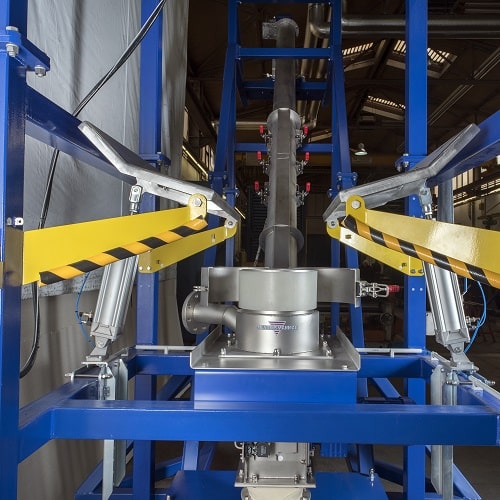
Connection of the big bag: silicone seal and half-shells with tension locks.
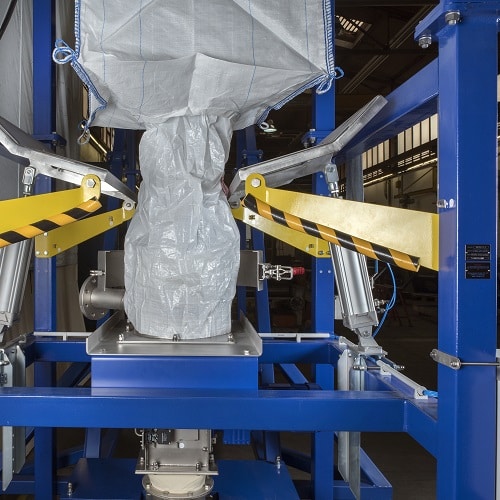
The big bag outlet is folded above a guide tube with silicone seal.
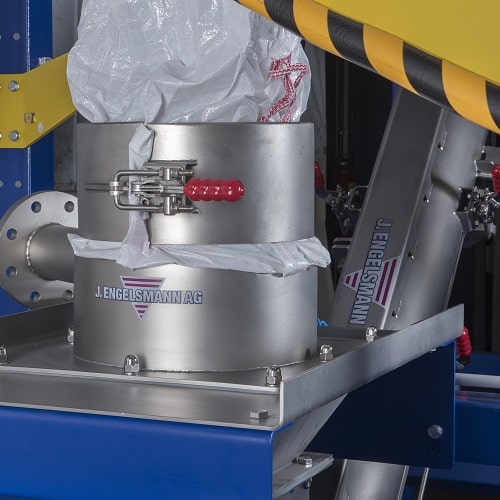
Half shells securely fix the big bag outlet during the emptying process.
Additional passing sieve, higher product quality
A passing sieve is integrated below the emptying device in each station to break up agglomerates in the product. This is important for accurate dosing in the packaging or smooth transport of the product in the conveying lines. If deagglomeration is not required, the screen basket can be pulled out in a few simple steps at the front of the screening machine and replaced by an open screen basket without a screen mesh. A protective sleeve protects the shaft pins.
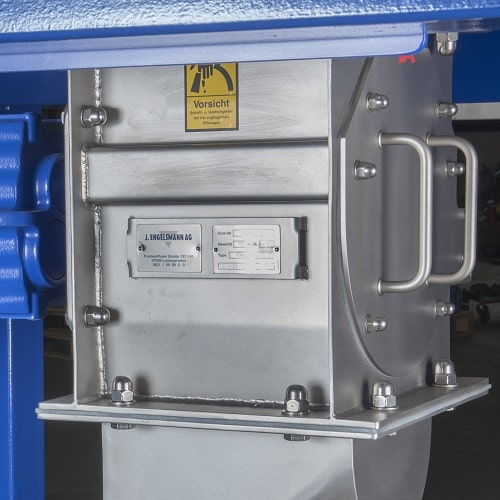
Passing sieve JEL PS: the screen basket can be pulled out and replaced easily
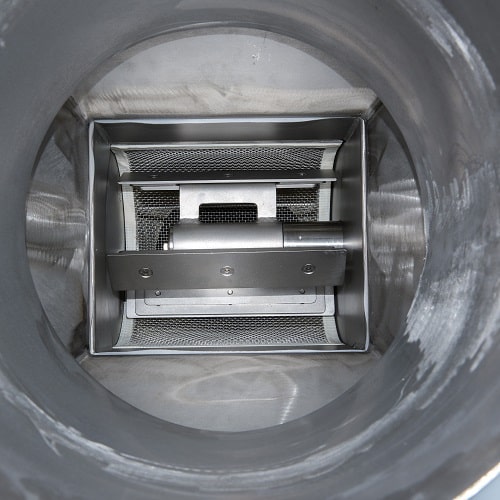
View into the interior of the passing screen: rotating bars scrape the product through the screen basket.
Handling of abrasive and non-abrasive bulk materials
Possible combinations with regard to the downstream conveying components
Thanks to the wide range of adaptation options resulting from the modular principle of the system, the customer can combine the individual components as required and react flexibly to different product properties. Shorter downtimes have enabled the packaging specialist to increase its productivity by 50%.
Variant for handling non-abrasive products
If the product is a non-abrasive bulk material to be conveyed into a weighing hopper or bagging machine on the same hall level, the system guides the product via a flexible compensator into a downstream inclined screw. The material is conveyed at a throughput rate of 500 kg/h over a trough length of 6 m at a steep 45° angle. Since residue-free cleaning of the system plays an enormously important role, especially for products from the food and pharmaceutical sectors, the tubular trough is a special design with trough segments that can be opened downward for cleaning. In accordance with accident prevention guidelines, these segments are mechanically secured against each other, with the uppermost segment being equipped with a limit switch safety device. In order to be able to use the inclined screw quickly when required, it is mounted on a mobile base frame for ease of operation.
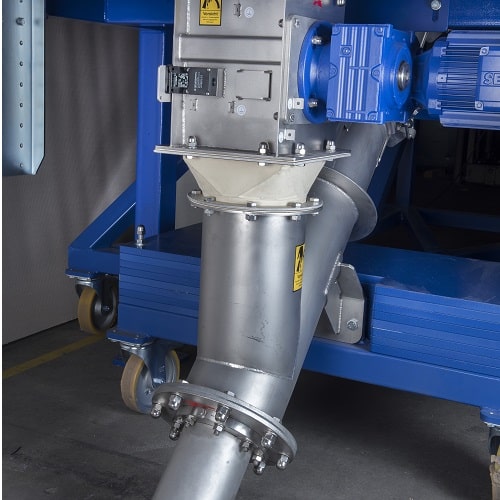
For products that can easily be conveyed mechanically, a mobile inclined screw is installed below the passing sieve.
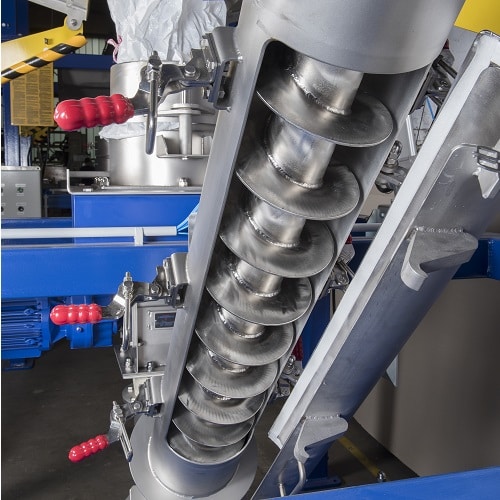
Screw conveyor with foldable trough segments
Arriving at the upper end of the inclined screw, the product flows through another compensator directly onto the JEL Fix vibrating screen, which is integrated in the frame to save space, for control screening. This vibration screening process cleans the bulk material of all unwanted foreign bodies before it finally flows into the weighing hopper or directly into the bagging machine – an important step prior to packaging as part of quality assurance, since despite strict hygiene and quality regulations it can never be completely ruled out that the product has not been contaminated unintentionally after all.
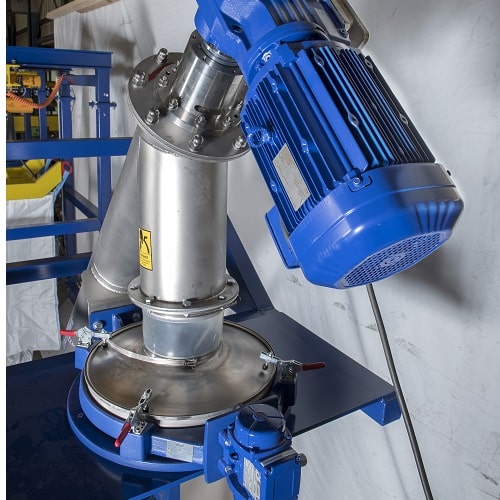
The protective screen has a low overall height and can therefore be attached to the outlet of the screw in a particularly space-saving manner.
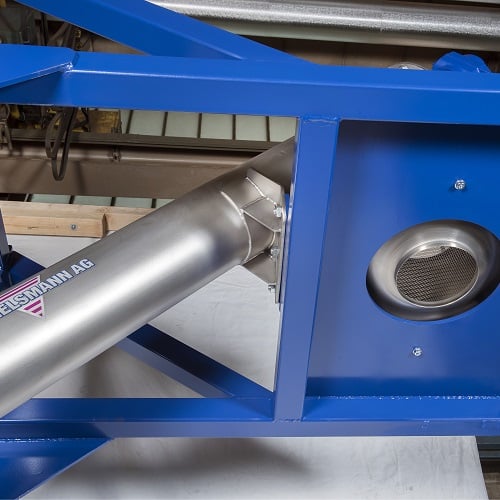
View into the outlet of the protective screen. From here, the product passes into the downstream process without foreign bodies.
Attention, abrasive product!
To enable the weighing and bagging machines to also be fed with abrasive material, such as salt, a second, adapted conveying solution was required.
Salt is difficult to convey mechanically because the inclined screws would wear out too quickly due to the high abrasion and corrosion. In this case, a switch is made to pneumatic conveying: instead of the compensator, the operator simply has to mount a product feed hopper under the outlet of the pass screening machine. After pass screening, the product flows directly through the hopper, which is equipped with a dedusting filter, and is extracted by the on-site pneumatic suction conveying line. This conveys the abrasive product to the next process step with little wear.
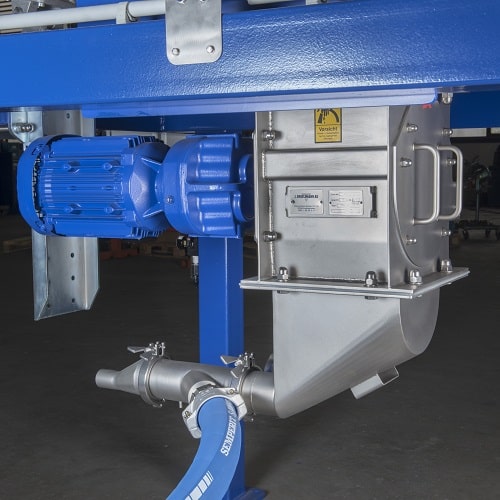
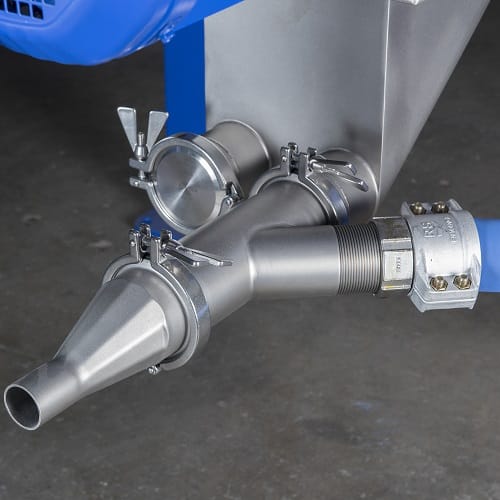
For abrasive products, a pneumatic feed device is mounted below the passing screen to connect the discharge station to a pneumatic conveying line.
To ensure that the system is also suitable for products from the food and pharmaceutical industries, all parts that come into contact with the product are FDA-compliant. After a three-month planning and delivery period, the CE-marked plant was delivered to the customer. A team from Engelsmann accompanied the assembly and took over the training of the operating personnel.

